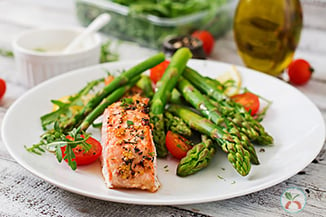A significant portion of your population likely needs to lose weight and lower LDL cholesterol levels. Maybe you do, too. Managing populations who are overweight and have high LDL cholesterol isn’t new. When we first wrote this blog post in 2010, we concluded that a primarily plant-based diet was the best approach for losing weight and lowering LDL cholesterol levels. That post has consistently ranked in our top ten most popular, but a lot can change in 10 years. We decided to see what current research reveals about the best diet for healthy weight loss and LDL cholesterol control.
The problems of elevated cholesterol levels and excess weight have gotten worse. Ten years ago, 27 percent of U.S. adults had high LDL cholesterol. Today, the prevalence has risen to 1 in 3. Statistics aren’t any better when we look at Americans’ weight: more than 2 in 3 are overweight or obese, yet according to a recent study, fewer Americans are attempting to lose weight by dieting today than 20 years ago. The researchers surmised the study participants did not try because they had failed at a prior attempt.
We also found that there are nearly as many opinions on how to lose weight as there are overweight people. Take high-fat, high-protein, low-carb diets, such as the Atkins diet, Keto diet, and Paleo diet, for example. They have been popular weight-loss approaches for at least 10 years, but none of these restrictive diets are best for achieving and maintaining both a healthy weight and healthy LDL cholesterol levels. Numerous studies have shown that eating a lot of red meat, animal products, and saturated fat raises cholesterol. These are also associated with increased risk for heart disease, cancer of the digestive tract, overall mortality, and acceleration of chronic kidney disease and kidney stones.
In contrast, eating a lot of fruits, vegetables, and plant-based proteins, such as legumes, nuts, and whole grains, lowers LDL cholesterol levels. This kind of diet can aid in weight management and minimizes risk from all-cause mortality. And as our 2018 Annual Data Review found, many of these dietary habits are also linked with happiness.
Recommending a plant-based diet aligns with a recent global study that showed that eating the wrong things—and not eating the right things—is causing more deaths than smoking. It turns out that the healthiest way to lose weight and lower cholesterol is also the best way to stay alive. The global study researchers set the following optimal levels and ranges for minimizing all-cause mortality risk:
- Fruits 250g (200-300) per day
- Vegetables 360g (290-430) per day
- Legumes 60g (50-70) per day
- Whole grains 125g (100-150) per day
- Nuts and seeds 21g (16-25) per day
- Milk 435g (350-520) per day
- Omega 3 250mg (200-300) per day
- Red meat (not processed) 23g (18-27) per day
This list reminds us of the Mediterranean Diet, which emphasizes fruits, vegetables, whole grains, legumes, olive oil, and fish. The ATTICA study determined that adherence to this type of diet helps people lose weight, control cholesterol levels, and lower their risk of cardiovascular disease. Again, these studies align with our 2010 recommendations: a diet high in plant proteins lowers weight and LDL cholesterol levels the best.
“I’m a proponent of quality, quantity, and moderation—higher quantity of high-quality foods, lower quantity of low-quality foods, and everything in moderation,” says Dr. Brittany U. Carter, Wellsource Director of Health & Research. “In the end, the ideal diet plan is one that provides a balance of nutrients and is one that an individual will adhere to long-term.”
The best way to control LDL cholesterol in your population is also the best way to help them maintain a healthy weight—but you need to make it as easy as possible for people to adopt a plant-based diet:
- To encourage them to eat primarily plant foods (fruits, vegetables, grains, legumes, and nuts), stock breakrooms and kitchens with fresh produce rather than processed and “convenience” foods.
- Educate individuals on the protein content of plant-based proteins. Serve tofu, nuts, legumes, and grains in your lunchroom rather than red meats.
- Model healthy food choices. Ask company managers to establish a corporate culture of health.
- Of course, to achieve weight loss, the daily calorie intake needs to be below metabolic needs. If your overweight population is ready to lose weight, consider a healthy weight education campaign, offering reimbursements on weight loss classes, daily walk groups, and other initiatives.
The exact foods eaten are a personal choice, but everyone should eat a wide variety of fruits, vegetables, and legumes for the most complete nutrient profile. A recent review of diet plans concluded that “there appears to be little weight loss advantage or difference in metabolic health outcomes between dietary approaches” such as low-fat or low-carbohydrate. The most important factor for each individual is to choose whichever one they can maintain at least long enough to achieve healthy cholesterol levels and weight goals.
Learn more about how to improve your population's health by downloading our white paper, 30 Ways to Encourage Wellness.
Note: This blog was first published January 28, 2010, and updated in 2019 to remain current with the latest standards and guidelines.








